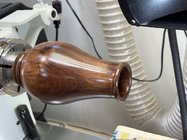Tom,
I agree with Doug above but only use epoxy on the inside. My work is sold in CO and is shipped to lots of environments: - I have work in Florida, Bermuda and in Australia - allowing for moisture change is critical.
Regarding your hollowing bar, I've used the Munro system since 2005 - it's been a love/hate relationship. I started with the original and then swore it off - couldn't get it to stop clogging plus the cutter attachment method was painful. Then a student got a Hollower-II, I tried and gave it another go - the cutter attachment method is a huge improvement.
The Munro is a nasty learning-curve. It's counter-intuitive: if it clogs, reduce the opening. Also, pressure is required to keep it cutting - my system utilizes an internal tool-rest with a pivot-pin at the opening - I stand back at the end of a three or four foot handle and apply the pressure needed to keep it cutting. When I pull it out to clear shavings, the cutter it totally clogged - I never bother to clean - just stick it back in and, voila, it cuts.
Needless to say, there is not a chuck on the planet that will allow the pressure I apply. On tall pieces, I always use a Keith Clark steady-rest. On low profile pcs (20"-dia, 15" tall), I use a 6" face-plate


